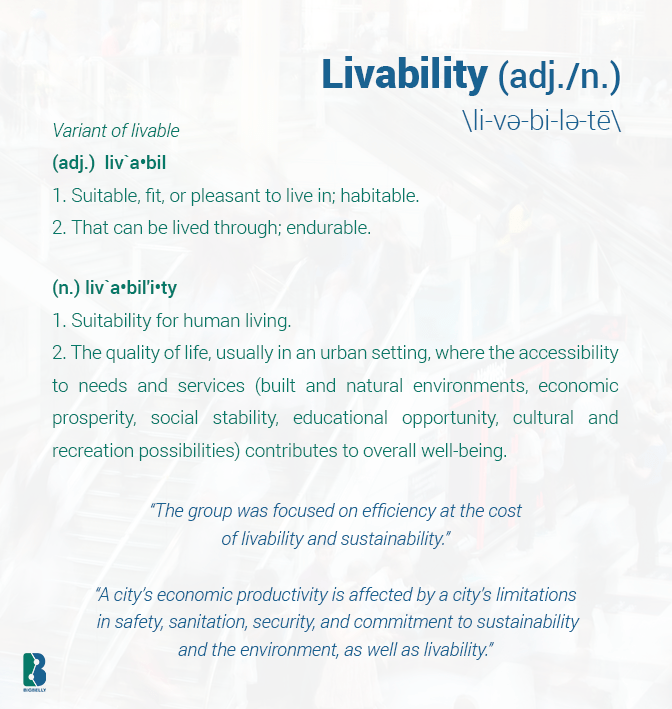
Livability describes the diverse aspects of society, surroundings, and shared experiences that shape a community. It focuses on the human experience and is specific to place and time. It includes economic, spatial, and social components that together are challenging to understand and measure in our defined world of planning and development of today’s communities for tomorrow. As such, it is best defined by the state, region, or community, and is best measured at a scale where consensus can be found.
A shared framework for livability was established by the Interagency Partnership for Sustainable Communities, formed in 2009. This collaboration of U.S. DOT, EPA, and HUD set forth the following six livability principles:
- Provide more transportation choices.
- Promote equitable, affordable housing.
- Enhance economic competitiveness.
- Support existing communities.
- Coordinate policies and leverage investment.
- Value communities and neighborhoods.
There is a growing movement to make communities around the globe more livable. The Making Cities Livable initiative aims to enhance the well-being of inhabitants of cities and towns, strengthen community, increase civic engagement, and improve social and physical health and sustainability by reshaping the built environment. The group’s goal is to by 2030 to:
- Rebuild community by replacing sprawl with compact, human scale urban fabric.
- Recognize and combat the negative impact of our built environment on physical, social, and mental health.
- Adopt planning and urban design decisions that will make our cities more livable for children and the elderly.
- Emphasize ethical land use patterns to reduce extreme economic disparities.
- Strengthen compact urban neighborhoods to maintain diversity of ethnic and cultural identity.
- Build multi-functional town squares that, like the ancient Greek agora or medieval marketplace, are capable of regenerating civic engagement, democratic participation, and use of public spaces.
Resolving these issues will help to rebuild cities so they are ecologically and socially sustainable. A number of case studies and representative definitions of livability exist. Here are a few of our favorites:
“A ‘livable future’ is one that is enduring, vibrant, responsible (civil), and offers a desirable quality of life. This requires a balance of three key societal goals: vibrant communities, vital economy, and sustainable environment.”
– WSDOT Livable Communities Policy
“The Livability Agenda aims to help citizens and communities: Preserve green spaces that promote clean air and water, sustain wildlife, and provide families with place to walk, play, and relax; Ease traffic congestion by improving road planning, strengthening existing transportation systems, and expanding use of alternative transportation; Restore a stense of community by fostering citizen and private sector involvement in local planning, including the placement of schools and other public facilities; Promote collaboration among neighboring communities – cities, suburbs, or rural areas – to develop regional growth strategies and address common issues like crime; and Enhance economic competitiveness by nurturing a high quality of life that attracts well-trained workers and cutting-edge industries.”
– Livable Communities Initiative
“Livability is best defined at the local level. Broadly speaking, a livable community recognizes its own unique identity and place a high value on the planning processes that help manage growth and change to maintain and enhance its community character.”
– American Institute of Architects



